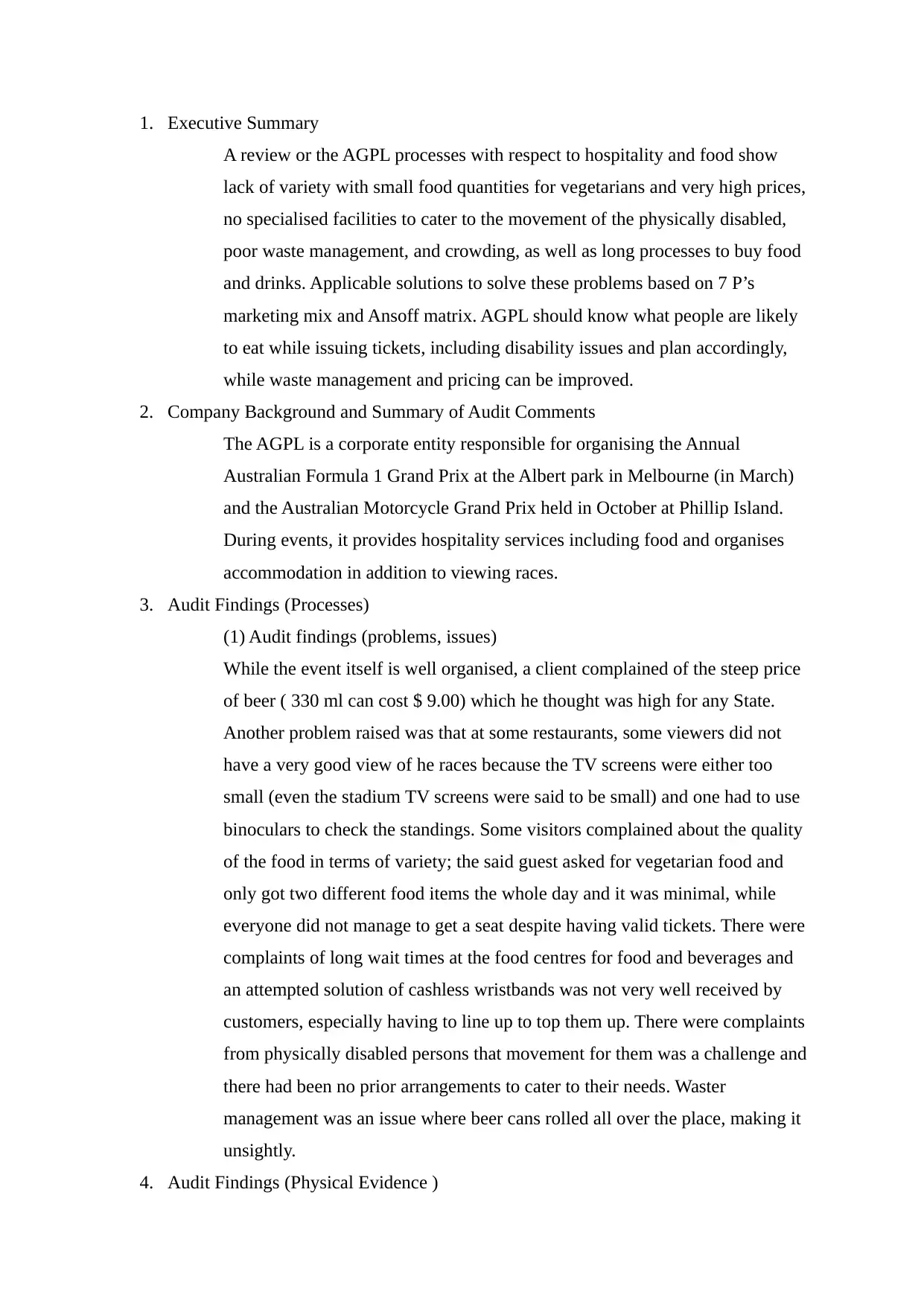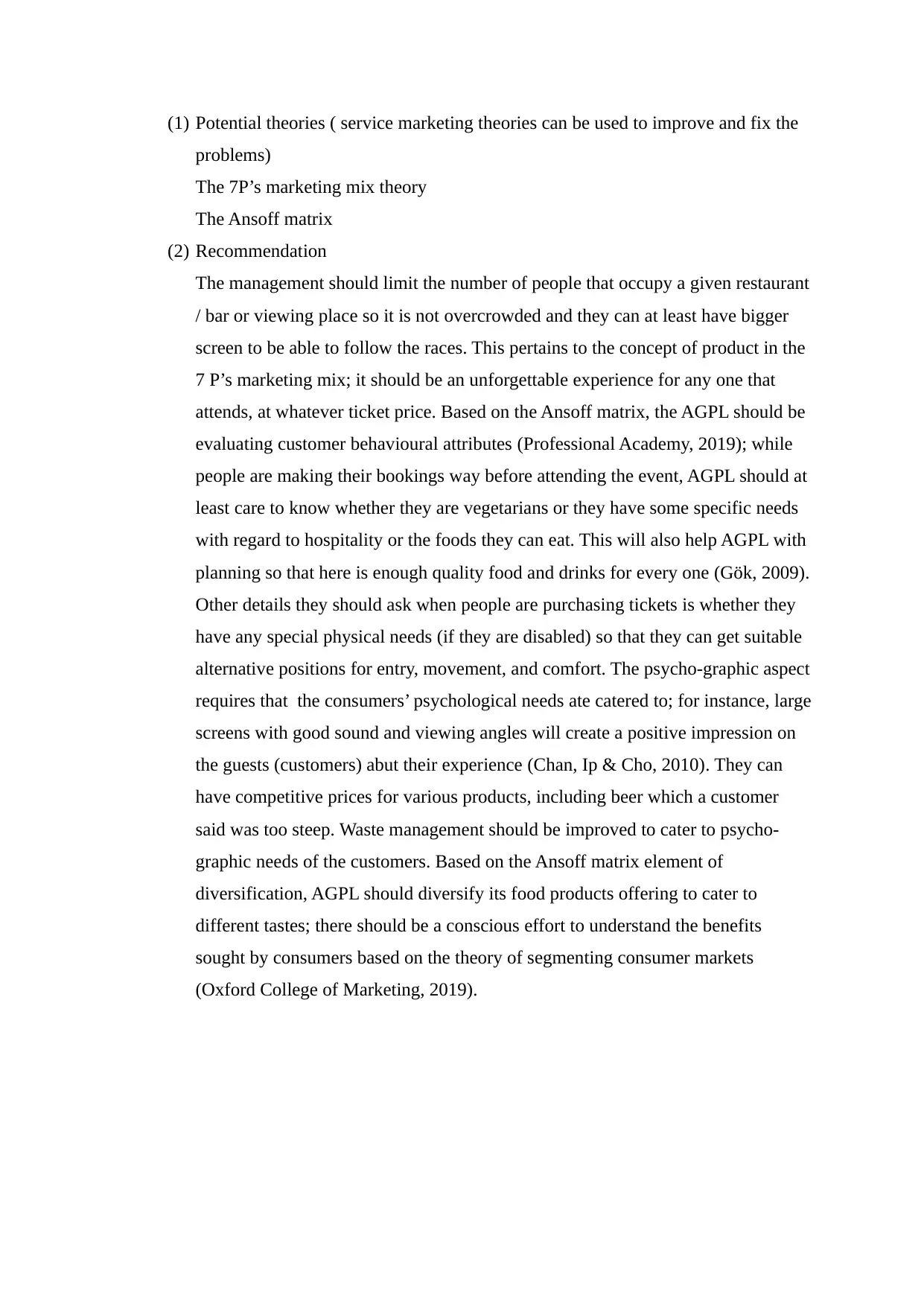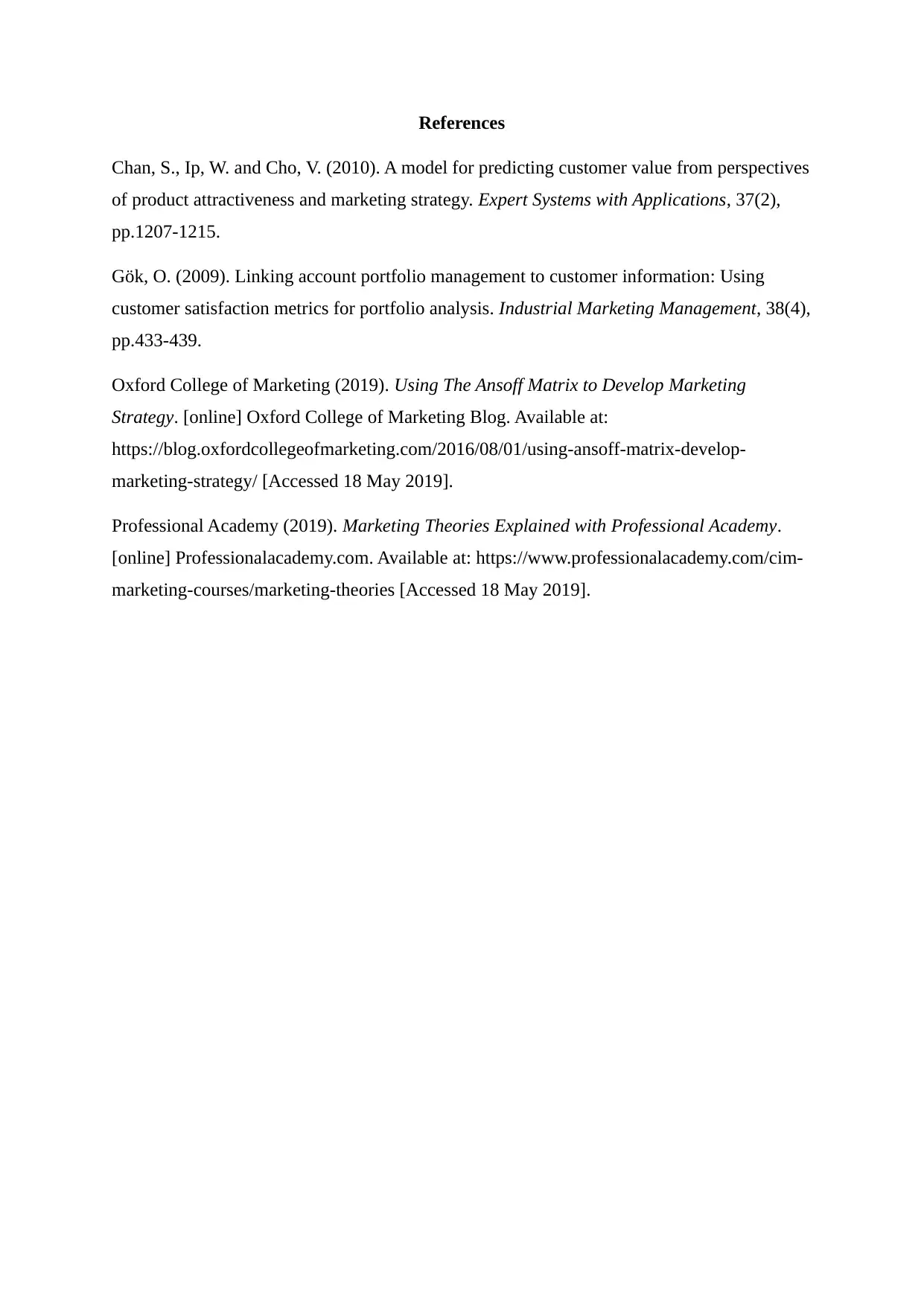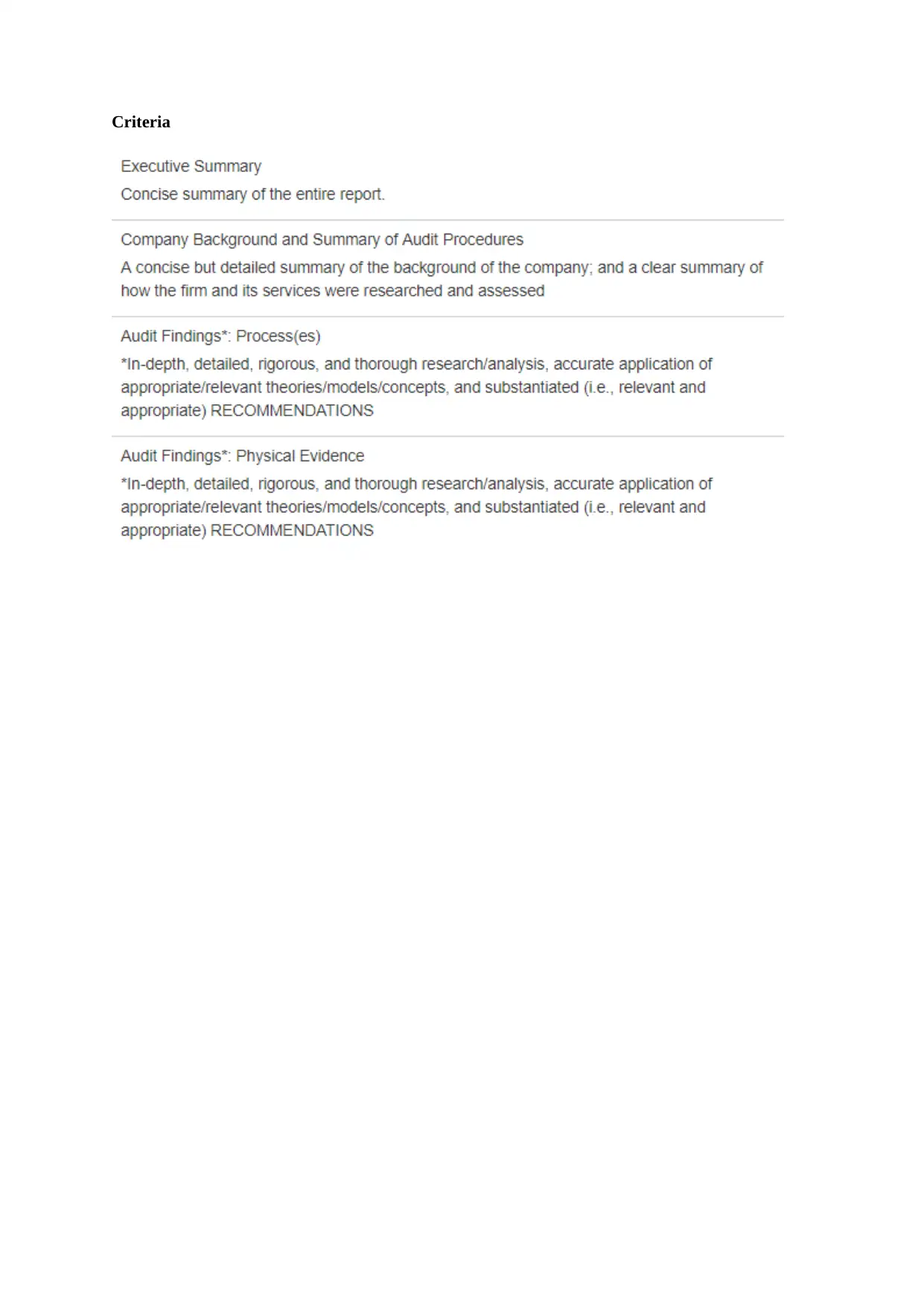Service Quality: Australian Grand Prix Hospitality Audit Report
VerifiedAdded on 2022/11/16
|5
|930
|191
Report
AI Summary
This report presents an executive summary of a service firm audit conducted on the Australian Grand Prix Corporation (AGPC), focusing on its corporate hospitality services. The audit identifies several issues, including high prices, limited food variety, inadequate facilities for disabled individuals, poor waste management, and overcrowding. The analysis applies the 7 P's marketing mix and the Ansoff matrix to propose solutions, such as diversifying food offerings, improving waste management, and gathering customer preferences. The recommendations emphasize the importance of understanding customer needs, enhancing the service environment, and ensuring an unforgettable experience. The report also highlights the need for improved customer experience through better planning and execution of hospitality services during the event.

Australian Grand Prix (corporate hospitality)
Paraphrase This Document
Need a fresh take? Get an instant paraphrase of this document with our AI Paraphraser

1. Executive Summary
A review or the AGPL processes with respect to hospitality and food show
lack of variety with small food quantities for vegetarians and very high prices,
no specialised facilities to cater to the movement of the physically disabled,
poor waste management, and crowding, as well as long processes to buy food
and drinks. Applicable solutions to solve these problems based on 7 P’s
marketing mix and Ansoff matrix. AGPL should know what people are likely
to eat while issuing tickets, including disability issues and plan accordingly,
while waste management and pricing can be improved.
2. Company Background and Summary of Audit Comments
The AGPL is a corporate entity responsible for organising the Annual
Australian Formula 1 Grand Prix at the Albert park in Melbourne (in March)
and the Australian Motorcycle Grand Prix held in October at Phillip Island.
During events, it provides hospitality services including food and organises
accommodation in addition to viewing races.
3. Audit Findings (Processes)
(1) Audit findings (problems, issues)
While the event itself is well organised, a client complained of the steep price
of beer ( 330 ml can cost $ 9.00) which he thought was high for any State.
Another problem raised was that at some restaurants, some viewers did not
have a very good view of he races because the TV screens were either too
small (even the stadium TV screens were said to be small) and one had to use
binoculars to check the standings. Some visitors complained about the quality
of the food in terms of variety; the said guest asked for vegetarian food and
only got two different food items the whole day and it was minimal, while
everyone did not manage to get a seat despite having valid tickets. There were
complaints of long wait times at the food centres for food and beverages and
an attempted solution of cashless wristbands was not very well received by
customers, especially having to line up to top them up. There were complaints
from physically disabled persons that movement for them was a challenge and
there had been no prior arrangements to cater to their needs. Waster
management was an issue where beer cans rolled all over the place, making it
unsightly.
4. Audit Findings (Physical Evidence )
A review or the AGPL processes with respect to hospitality and food show
lack of variety with small food quantities for vegetarians and very high prices,
no specialised facilities to cater to the movement of the physically disabled,
poor waste management, and crowding, as well as long processes to buy food
and drinks. Applicable solutions to solve these problems based on 7 P’s
marketing mix and Ansoff matrix. AGPL should know what people are likely
to eat while issuing tickets, including disability issues and plan accordingly,
while waste management and pricing can be improved.
2. Company Background and Summary of Audit Comments
The AGPL is a corporate entity responsible for organising the Annual
Australian Formula 1 Grand Prix at the Albert park in Melbourne (in March)
and the Australian Motorcycle Grand Prix held in October at Phillip Island.
During events, it provides hospitality services including food and organises
accommodation in addition to viewing races.
3. Audit Findings (Processes)
(1) Audit findings (problems, issues)
While the event itself is well organised, a client complained of the steep price
of beer ( 330 ml can cost $ 9.00) which he thought was high for any State.
Another problem raised was that at some restaurants, some viewers did not
have a very good view of he races because the TV screens were either too
small (even the stadium TV screens were said to be small) and one had to use
binoculars to check the standings. Some visitors complained about the quality
of the food in terms of variety; the said guest asked for vegetarian food and
only got two different food items the whole day and it was minimal, while
everyone did not manage to get a seat despite having valid tickets. There were
complaints of long wait times at the food centres for food and beverages and
an attempted solution of cashless wristbands was not very well received by
customers, especially having to line up to top them up. There were complaints
from physically disabled persons that movement for them was a challenge and
there had been no prior arrangements to cater to their needs. Waster
management was an issue where beer cans rolled all over the place, making it
unsightly.
4. Audit Findings (Physical Evidence )

(1) Potential theories ( service marketing theories can be used to improve and fix the
problems)
The 7P’s marketing mix theory
The Ansoff matrix
(2) Recommendation
The management should limit the number of people that occupy a given restaurant
/ bar or viewing place so it is not overcrowded and they can at least have bigger
screen to be able to follow the races. This pertains to the concept of product in the
7 P’s marketing mix; it should be an unforgettable experience for any one that
attends, at whatever ticket price. Based on the Ansoff matrix, the AGPL should be
evaluating customer behavioural attributes (Professional Academy, 2019); while
people are making their bookings way before attending the event, AGPL should at
least care to know whether they are vegetarians or they have some specific needs
with regard to hospitality or the foods they can eat. This will also help AGPL with
planning so that here is enough quality food and drinks for every one (Gök, 2009).
Other details they should ask when people are purchasing tickets is whether they
have any special physical needs (if they are disabled) so that they can get suitable
alternative positions for entry, movement, and comfort. The psycho-graphic aspect
requires that the consumers’ psychological needs ate catered to; for instance, large
screens with good sound and viewing angles will create a positive impression on
the guests (customers) abut their experience (Chan, Ip & Cho, 2010). They can
have competitive prices for various products, including beer which a customer
said was too steep. Waste management should be improved to cater to psycho-
graphic needs of the customers. Based on the Ansoff matrix element of
diversification, AGPL should diversify its food products offering to cater to
different tastes; there should be a conscious effort to understand the benefits
sought by consumers based on the theory of segmenting consumer markets
(Oxford College of Marketing, 2019).
problems)
The 7P’s marketing mix theory
The Ansoff matrix
(2) Recommendation
The management should limit the number of people that occupy a given restaurant
/ bar or viewing place so it is not overcrowded and they can at least have bigger
screen to be able to follow the races. This pertains to the concept of product in the
7 P’s marketing mix; it should be an unforgettable experience for any one that
attends, at whatever ticket price. Based on the Ansoff matrix, the AGPL should be
evaluating customer behavioural attributes (Professional Academy, 2019); while
people are making their bookings way before attending the event, AGPL should at
least care to know whether they are vegetarians or they have some specific needs
with regard to hospitality or the foods they can eat. This will also help AGPL with
planning so that here is enough quality food and drinks for every one (Gök, 2009).
Other details they should ask when people are purchasing tickets is whether they
have any special physical needs (if they are disabled) so that they can get suitable
alternative positions for entry, movement, and comfort. The psycho-graphic aspect
requires that the consumers’ psychological needs ate catered to; for instance, large
screens with good sound and viewing angles will create a positive impression on
the guests (customers) abut their experience (Chan, Ip & Cho, 2010). They can
have competitive prices for various products, including beer which a customer
said was too steep. Waste management should be improved to cater to psycho-
graphic needs of the customers. Based on the Ansoff matrix element of
diversification, AGPL should diversify its food products offering to cater to
different tastes; there should be a conscious effort to understand the benefits
sought by consumers based on the theory of segmenting consumer markets
(Oxford College of Marketing, 2019).
⊘ This is a preview!⊘
Do you want full access?
Subscribe today to unlock all pages.

Trusted by 1+ million students worldwide

References
Chan, S., Ip, W. and Cho, V. (2010). A model for predicting customer value from perspectives
of product attractiveness and marketing strategy. Expert Systems with Applications, 37(2),
pp.1207-1215.
Gök, O. (2009). Linking account portfolio management to customer information: Using
customer satisfaction metrics for portfolio analysis. Industrial Marketing Management, 38(4),
pp.433-439.
Oxford College of Marketing (2019). Using The Ansoff Matrix to Develop Marketing
Strategy. [online] Oxford College of Marketing Blog. Available at:
https://blog.oxfordcollegeofmarketing.com/2016/08/01/using-ansoff-matrix-develop-
marketing-strategy/ [Accessed 18 May 2019].
Professional Academy (2019). Marketing Theories Explained with Professional Academy.
[online] Professionalacademy.com. Available at: https://www.professionalacademy.com/cim-
marketing-courses/marketing-theories [Accessed 18 May 2019].
Chan, S., Ip, W. and Cho, V. (2010). A model for predicting customer value from perspectives
of product attractiveness and marketing strategy. Expert Systems with Applications, 37(2),
pp.1207-1215.
Gök, O. (2009). Linking account portfolio management to customer information: Using
customer satisfaction metrics for portfolio analysis. Industrial Marketing Management, 38(4),
pp.433-439.
Oxford College of Marketing (2019). Using The Ansoff Matrix to Develop Marketing
Strategy. [online] Oxford College of Marketing Blog. Available at:
https://blog.oxfordcollegeofmarketing.com/2016/08/01/using-ansoff-matrix-develop-
marketing-strategy/ [Accessed 18 May 2019].
Professional Academy (2019). Marketing Theories Explained with Professional Academy.
[online] Professionalacademy.com. Available at: https://www.professionalacademy.com/cim-
marketing-courses/marketing-theories [Accessed 18 May 2019].
Paraphrase This Document
Need a fresh take? Get an instant paraphrase of this document with our AI Paraphraser

Criteria
1 out of 5
Your All-in-One AI-Powered Toolkit for Academic Success.
+13062052269
info@desklib.com
Available 24*7 on WhatsApp / Email
![[object Object]](/_next/static/media/star-bottom.7253800d.svg)
Unlock your academic potential
Copyright © 2020–2025 A2Z Services. All Rights Reserved. Developed and managed by ZUCOL.

